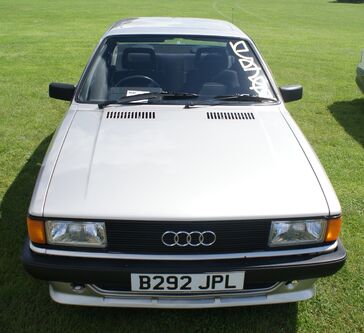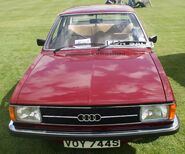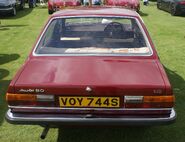
Audi 80
The Audi 80 is a compact executive car produced by the German car manufacturer Audi, from 1966 to 1996. It shared its platform with the Volkswagen Passat from 1973 to 1986 and was available as a saloon car/sedan, and an Avant (Audi's name for an estate car/station wagon). The coupé and convertible models were not badged as members of the range but shared the same platform and many parts.
In North America and Australia, the 80 was sold as the Audi Fox for model years 1973–79, and as the Audi 4000 for model years 1980–87 in the USA. The Audi 90 was an upmarket version of the Audi 80. The original Audi Cabriolet was badged thus, without a number, but was closely related to the 80/90.
There were several different internal combustion engine types, of which the petrol engines included the fuel-injected "E" (Einspritzung), and carburetor "S", and the diesel engines included "D" (Diesel), "TD" (TurboDiesel), or "TDI" (Turbocharged Direct Injection)
F103 (1966–69)[]
Main article: Audi F103The Audi F103 series, based on the DKW F102 but with an all new range of four-stroke engines developed in conjunction with Daimler-Benz, sold between 1965 and 1972, comprised several models named for their horsepower ratings. From 1966 to 1969, this series included an Audi 80 model, but there were also 60, 72, 75, and Super 90 Audis available over the years.
B1 (1972–78)[]
This model debuted in Europe in 1972 (with factory production starting in May 1972) as the Audi 80, and in 1973 in Australia and the United States as the Audi Fox, and was available as either a two-door or a four-door saloon (sedan). It effectively took the place of several models that Audi had discontinued (the F103 series, which included the first model designated as an "Audi 80"), and provided the company with a viable rival to the Opel Ascona and the Ford Taunus.
The Audi 80 was first equipped with 1.3- and 1.5-litre SOHC straight-4 petrol engines. The internal combustion engines were available in various rated power outputs. For the 1.3 L engines, (identification code: ZA) was rated at 55 PS (40 kW; 54 bhp), code: ZF was rated at 60 PS (44 kW; 59 bhp). The 1.5 L (codes: ZB, ZC) at 75 PS (55 kW; 74 bhp) for the ZB and 85 PS (63 kW; 84 bhp) for the ZC.
On the home market, two- and four- door saloons were available in base trim (55 or 60 PS, called simply Audi 80 and 80 S, respectively), as L models (LS with 75 PS engine) or as a more luxurious GL (85 PS only). In September 1973, Audi added the sporty 80 GT (two-door only) featuring a carburetted 1.6-litre engine (code: XX) rated at 100 PS (74 kW; 99 bhp).
The Audi 80 had a MacPherson strut front suspension, and a C-section beam rear axle located by trailing arms and a Panhard rod, and using coil springs and telescopic dampers.
Audi's design and development efforts paid off during the 1973 European Car of the Year competition where the 80 won ahead of the Renault 5 and the Alfa Romeo Alfetta.
A facelift in autumn 1976 brought about a revised front end in the style of the newly introduced Audi 100 C2 with square instead of round headlights, 1.6- instead of 1.5-litre engines (still of 75/85 PS) and a new 80 GTE model with a fuel-injected version of the 1.6-litre (110 PS (81 kW; 110 bhp)) replacing the former 80 GT.
The Fox had a 1.5 L engine rated at 55 hp (41 kW; 56 PS) attached to a four-speed manual transmission. Subsequent versions came with 1.6 L engines rated at 83 hp (62 kW; 84 PS).
In certain markets a five-door "Avant" (Audi's name for an estate/wagon) variant was offered — effectively a rebadged Volkswagen Passat with Audi front panels. The B1 platform was dropped from the European market in 1978, although it was sold into the 1979 model year in North America.
B2 (1978–86)[]
Audi redesigned the 80 on the B2 platform (Typ 81) in 1978 in Europe, and in 1979 (as a 1980 model) in North America. Audi continued to use the 80 nameplate in Europe, but began badging it as the 4000 in North America. The body of the B2 Audi 80 was designed by Giorgetto Giugiaro. Although it was usually ordered as a four-door, a smaller number of two-door 80s were produced. No Avant variant was available, as the Volkswagen Passat filled that role.
In Europe, the 80 was the standard model, while after a 1984 facelift the Audi 90 was launched as a larger-engined version of the 80; with more options, and, aside from the 70 PS (51 kW; 69 bhp), four-cylinder 1.6l turbodiesel (TD) engine which was also available for the 80, two five-cylinder in-line petrol engines — a 2.0 with 115 PS (85 kW; 113 bhp) and a 2.2 with 136 PS (100 kW; 134 bhp) which was later modified into a 2.3. The 2.2 was available with a catalytic converter and power ratings of 115 PS (85 kW; 113 bhp) for front-drive and 120 PS (88 kW; 118 bhp) for quattro models. European models had two headlamp casings, while North American models generally had quad headlamps.
The Audi 5+5 was launched on to the Australian market in October 1981 and was described as a "uniquely Australian Special". After the Australian motoring press had driven the new B2 Audi 80, they beckoned Audi to fit the five-cylinder engine from the larger Audi 100. The 5+5 was essentially an 80 B2 four-door saloon with the 2,144 cc five-cylinder engine, the precursor to what would become the Audi 90.
In 1983, the 80 Sport was introduced in the UK, based on the GTE. It came with quattro-style Ronal alloys, rubber rear spoiler, deep chin spoiler, striped charcoal Recaro interior, and optional body graphics including full-length "Audi Sport" stripes. A special commemorative-edition version, the Audi 4000CS quattro, was made for the 1985, 1986, and 1987 model years.
Mid-1984, for the 1985 model year, Audi gave the B2 a subtle facelift with tail lights resembling the ones of the Typ 44 Audi 100, and different front and rear bumpers and headlights and an updated interior. In Europe, engines with catalytic converter emissions controls were made available for the first time.
The B2 platform proved to be both quite versatile and quite profitable; many components were shared to or borrowed from the Audi Coupé, Audi Quattro and Audi Sport Quattro, which in the process helped to cement the company into the public eye after their quattro permanent four-wheel drive system proved useful in various forms of racing.
The saloons were offered until late 1986 in Europe and 1987 abroad, and the B2-based Audi Coupé lasted through to 1988 (as an early 1989 model) before being changed. The Coupé shared many components, and its basic body shape, with the original Audi Quattro.
4000 (1980–87)[]
The North American Audi 4000 was sold in 4000S (1.8 L) and 4000CS quattro (2.2 L) derivatives, with the CS quattro being very similar to the European Audi 90 quattro.
The CS quattro had a CIS-E fuel-injected 2.2-litre inline 5-cylinder petrol engine (identification code: JT). It displaced 2,226 cc, was constructed from a grey cast iron cylinder block, with an aluminium alloy cylinder head, and used a timing belt-driven single overhead camshaft (SOHC). The rated horsepower was 86 kW (117 PS; 115 bhp) at 5,500 rpm, and the torque is 171 N·m (126 lbf·ft) at 3,000 rpm. The only transmission available on the 4000S/CS was a five-speed close-ratio manual.



